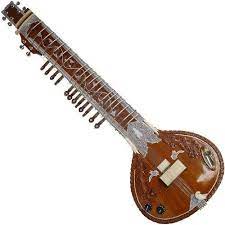
"Sitar: Strings of Melodic Splendor"
In the resplendent tapestry of musical instruments, the Sitar emerges as an iconic symbol of India's rich cultural heritage, melodic intricacy, and artistic elegance. With its mesmerizing tones, intricate craftsmanship, and profound musical legacy, the Sitar stands as an embodiment of musical finesse and timeless resonance. Let's embark on a melodic journey to explore the origins, design, playing techniques, cultural significance, and enduring allure of the Sitar.
Historical Roots:
The Sitar's lineage traces back to ancient Indian musical traditions, evolving from Persian and Indian stringed instruments. Its contemporary form was refined in the Mughal courts, gaining prominence as a symbol of artistry and cultural refinement.
Design and Construction:
Crafted from seasoned gourds, seasoned wood, and metal strings, the Sitar's distinctive pear-shaped body and long neck are adorned with intricate carvings and 'jawari'—the curved bridge that enhances its resonance and tonal richness.
Melodic Complexity:
The Sitar's unique design features sympathetic strings, a main melody string ('baaj'), and movable frets, allowing for a vast array of microtonal variations, melodic ornamentations ('meend'), and emotive slides ('gamak').
Playing Techniques:
Sitar maestros exhibit virtuosity through intricate 'ragas' and rhythmic cycles ('talas'), exploring a palette of melodic expressions through 'alap,' 'jor,' 'jhala,' and 'gat,' showcasing improvisational mastery and technical brilliance.
Cultural Significance:
The Sitar symbolizes India's cultural heritage, spirituality, and artistic refinement. Its presence in classical concerts, collaborations with other instruments, and its representation in Indian music's narrative make it an emblem of musical tradition and artistic expression.
Global Resonance:
Beyond its cultural origins, the Sitar has captivated audiences worldwide, influencing Western music and collaborating across genres, illustrating its universal appeal and cross-cultural significance.
Enduring Legacy:
As Sitar virtuosos continue to push boundaries, preserve classical traditions, and innovate with contemporary fusions, the instrument's legacy remains etched in the annals of music, inspiring generations of musicians worldwide.
Conclusion: Melodic Elegance, Cultural Reverberation
The Sitar's enchanting melodies, intricate craftsmanship, and rich cultural heritage epitomize the enduring beauty and emotive depth of Indian classical music. Its strings resonate with the soulful narratives, intricate rhythms, and profound emotions that echo through generations—a testament to the Sitar's timeless allure and enduring legacy in the world of music.
As its melodic splendor continues to enthrall audiences and bridge cultural boundaries, the Sitar stands as a testament to the profound beauty and universal language of music—a language that transcends borders and unites hearts in its harmonious resonance.
The Sitar's intricacy and profound musical heritage make it an indelible part of India's cultural fabric and a captivating instrument in the global musical landscape
ABOUT AUTHOR : Musicintuit Admin
EXPLORE OUR ARRAY OF ONLINE MUSIC COURSES: Musicintuit Courses
ENROLL TODAY ! EXPLORE AND IMMERSE YOURSELF IN THE REALM OF MUSIC: Contact Musicintuit




